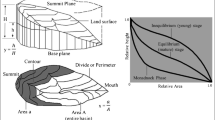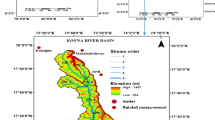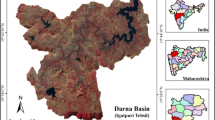Abstract
In this paper, the hypsometric curves and integrals of four neighboring micro-watersheds draining into Patiala-Ki-Rao stream which is situated in the Shivalik foothills of district SAS Nagar in the Punjab state (India) has been presented to access and compare the erosion regimes under different management practices. Area-elevation ratio method has been used to compute hypsometric curve and integral values for each micro-watershed through ArcGIS 10.3 and Microsoft Excel. The 9-year data of runoff and sediment yield for all these micro-watersheds under different management practices has been analyzed for their effect on land cover and soil quality. Thus, the results of present study are very useful for comparing, planning, implementing, and controlling soil erosion in similar watersheds.
Similar content being viewed by others
Avoid common mistakes on your manuscript.
Introduction
Today, soil erosion is universally recognized as a serious threat to the well-being of mankind. World-wide current rate of land degradation by soil erosion and other factors is leading to an irreparable loss. El-Swaify (1997), in his study, reported that among all continents, Asia had the highest soil erosion rate of 74 ton/acre/year with Asian rivers contributing about 80% of the total sediments delivered to the world oceans. Stoddart (1969) further documented that among Asian rivers, the Himalayan rivers were the major contributors of sediment disposal owing to the fact that Himalayas were one of the most ecologically fragile and economically underdeveloped regions (Tiwari et al. 2000). Shivaliks constituting the north-western foothills of the Himalayas and falling in the states of Jammu and Kashmir, Punjab, Himachal Pradesh, Haryana, and Uttar Pradesh are geologically weak, unstable, and highly prone to erosion. Thus, soil and water conservation techniques are needed for proper planning and efficient utilization of the land and water resources in the area. Previous studies have revealed that hypsometric analysis helps us in explaining the erosion status that had taken place in the watershed. Hypsometric measurements had been used for different drainage basins, in order to compare present volume to the original volume of the basin by many researchers. The hypsometric curve of a watershed was first introduced by Langbein (1947) and was further interpreted by Strahler (1952) as an independent comparable unit in terms of basin dissection and relative age. He predicted youthful stage by convex-up curves with high hypsometric integrals and un-dissected basins, mature stage by S-shaped curves, and concave-up curves with low hypsometric integrals for old and dissected basins. It was also found by Strahler (1952) that the hypsometric integral is inversely correlated with total relief, slope steepness, drainage density, and channel gradients.
Hurtrez et al. (1999) studied the sensitivity of hypsometry to digital elevation model of different resolutions and predicted the influence of varying drainage areas on hypsometry in Siwalik Hills of Central Nepal. Awasthi et al. (2002) investigated hypsometric curves and integrals of two watersheds in Nepal and predicted severe erosion in these watersheds. According to Ritter et al. (2002) and Perez-Pena et al. (2009), the shape of a hypsometric curve gives indication of changes in geomorphology and the relative age of watersheds. Generally, convex shape curve indicates younger geomorphology; and concave curves and S-shapes predict mature stage. The different shapes of hypsometric curve and hypothetical standards to determine different stages of hypsometric integrals have been given in Fig. 4 and Table 1. Ozkaymak and Sozbilir (2012) predicted that hypsometric integrals less than 0.30 were generally considered to be denuded or mature stage of basin, whereas hypsometric integrals greater than 0.60 were considered unstable, actively uplifting, or young basins. The percentage of hypsometric and erosion integrals were computed using the following equation:
Golekar et al. (2015) analyzed landscape information such as longitudinal profile, hypsometric analysis, and geomorphological studies of Anjani and Jhiri river basin, Jalgaon district, Maharashtra, India, and recommended suitable site for soil and water conservation for future. It was clear from the review of literature that hypsometric measurements had been used for different drainage basins, in order to compare present volume to the original volume of the basins by many researchers to check the erosion status, but there was a need to check the effect of management practices on hypsometry of basins. In this paper, the hypsometric study of four micro-watersheds has been undertaken to compare their erosion status under different management practices to conserve soil and water.
Study area
The study area is located between 30° 48′ North and 76° 49′ East at the lower left, and 30° 50′ North and 76° 50′ East at the upper right of the Patiala-Ki-Rao basin (Fig. 1) which originates from the steep slopes of Shivalik foothills and passes through the undulated forests to create a flood plain. The study area is situated at an elevation of 415 m above the mean sea level. Four hydrologic measurement stations at the outlets of these micro-watersheds are located at Karoran village of district SAS Nagar (Punjab), India, where the two tributaries of Patiala-Ki-Rao join together at the Shivalik foothills. The water flows in these tributaries only during the rainy season from July to September. The instruments installed for recording the watershed data were automatic stage-level recorders, sediment samplers, V-notch at micro-watershed-I (MW-I), Parshall flume at micro-watershed II (MW-II) and micro-watershed III (MW-III), and rectangular notch at micro-watershed IV (MW-IV). Engineering, vegetation, and fencing were applied to MW-I having an area of 15.6 ha. Some temporary loose boulder check dams had been constructed on the drainage line of the MW-I to reduce the channel gradient. Vegetation and fencing were applied to the drainage line of MW-II having an area of 12.5 ha. Only fencing was applied on the drainage line of MW-III having an area of 10.9 ha, whereas no treatment was applied to MW-IV having an area of 3.59 ha; the watershed was exposed to grazing.
Climate
Semi-arid climate existed in the area under study. Rainfall constituted the major source of water. Average annual rainfall in the area varied from 850 to 1250 mm. The rains were inconsistent, and more than 80% of high-intensity and short-duration rains occurred during the monsoon months. However, some light showers were also received from December to March. Generally, the summers remained hot and winters cool. The maximum temperature was recorded as 41–44 °C, whereas the minimum temperature remained in the range of 5–6 °C. Most of the monsoon rainfall goes as runoff causing soil erosion from the contributing basin along with the selected micro-watersheds as the area was ecologically fragile, unstable, and highly prone to erosion.
Materials and methods
Geospatial techniques have become an indispensable scientific tool for mapping and monitoring of natural resources and used for watershed management, geomorphic, and land use analysis. ASTER DEM of 30-m resolution and outlet positions located at runoff gauging stations by GPS were used as input for extracting boundaries, contours generation, morphometric, and hypsometric analysis to study micro-watersheds using the ArcGIS Spatial Analyst tool. Land use and soil map had been prepared by digitizing high-resolution satellite data of World View provided by Punjab Remote Sensing Centre (PRSC) in ArcGIS 10.3 software. The runoff and sediment load data of four gauged micro-watersheds for the period 2007 to 2015 as shown in Figs. 7 and 8 were collected from the Director of PAU Zonal Research Station for Kandi Area, Ballowal Saunkhari, district Shaheed Sukhdev Singh Nagar, Punjab. Soil samples of all these micro-watersheds were first collected from the fields, and then laboratory analysis was carried out to monitor its health status.
Soil
The major soil group of the study area was Ustorthents. Soil texture varied from loamy sand to sandy loam as shown in Fig. 2 having low to medium moisture retention capacity. Soil samples of all these micro-watersheds were first collected from the fields, and then laboratory analysis was carried out to monitor its health status. It was found from lab analysis that the surface soils were having a very low percentage of organic matter ranging from 0.03 to 0.15. This may be due to erosion of topsoil with runoff during rainy season before proper decomposition. The soils were light textured and easily erodible with pH ranging from 8.0 to 8.2. Permeability was very low, and the aquifer was found below 250 mbgl even in sandier phase. The layer of stream bed at the outlets comprised of stones, sand, silt, clay, and conglomerate deposits swept down by seasonal dissected ephemeral streams of Shivaliks. A thick bed of sand was observed along the stream.
Land use
Four land use categories as identified in the study area have been presented in Fig. 3. The forest area appeared as the major land use category. The micro-watersheds were non-arable forest rangeland, and the land surface was covered with grass, bushes, and scattered trees. The tree species such as Dalbergia sissoo (Shisham), Acacia catechu (Khair), Acacia nilotica (Kikar), and Eucalyptus tereticornis (Safeda) were dominant in the area under study. The bush species such as Lantana indica, Karonda, Z. numularia (jungli Ber), Mehnder, Adatoda, and Murraya koengii (Karripatta), and local grass species like Eulaliopsis binnata (Bhabar), Kana, S. spontaneum (Kahi), Bansa, Cynodon dactylon (Dub), Dholu, and Aristida were common in this area. A small proportion of land use area was under agriculture. As the ground water is very deep in this area, only rain-fed crops such as maize and fodder are sown by the farmers.
Results and discussion
The morphometric and hypsometric analyses were carried out with quantitative description of the micro-watershed geometry in numerical terms, and their relationship with other parameters has been examined to understand, predict, and compare its behavior under different management practices in terms of runoff and sediment yield (Fig. 4).
Morphology
Different morphometric parameters have been computed and summarized in Tables 2 and 3 for the study micro-watersheds. MW-I and MW-III were classified as fourth-order micro-watersheds, whereas MW-II and MW-IV were classified as third-order micro-watersheds. The presence of a large number of streams in MW-I indicated that the topography was undergoing erosion, while a less number of streams for MW-IV indicated its mature topography. Bifurcation ratio was an important parameter for linking hydrological regimes of watershed under topological and climatic condition (Raj et al. 1999). In the present study, the bifurcation ratio of the lower order showed a higher value of stream order, which indicated high dissection in the upland area except MW-I where third-order stream had a higher bifurcation ratio than the second-order stream. This indicates that the area is tectonically active and needs some structural control. The length of overland flow for all the micro-watersheds was more or less equal and varied from 0.0102 to 0.011 km. The small values of overland flow indicate towards a quicker and large surface runoff, and even a less rainfall causes soil loss.
Elongation ratio, circulatory ratio, and form factor were used to define the basin shape. These were found to be useful in hydrological study of a basin. Form factor and elongation ratio of MW-II and MW-IV were less as compared to those of MW-I and MW-III, which indicated that MW-II and MW-IV were more elongated as compared to MW-I and MW-III. The ratio of total relief to horizontal distance along the longest dimension of the basin parallel to the main drainage line is relief ratio (Schumn 1956). Runoff and soil loss per unit area were closely correlated with relief ratios as runoff was faster in steeper watersheds with greater erosive strength. In the present study, the value of relief ratio for MW-I was more than that for other micro-watersheds. Ruggedness number is a dimensionless parameter which represents the product of basin relief and drainage density. Watersheds having high values of ruggedness number were characterized by dynamic geomorphic processes, long and steep slopes, and high susceptibility to soil erosion. The values of ruggedness number were observed to be higher in MW-I, MW-II, and MW-III as compared to MW-IV, which led to more runoff and erosion due to more dissected surface in MW-I, MW-II, and MW-III as compared to MW-IV.
All the morphometric parameters quantified in the micro-watershed study indicated that MW-IV was less susceptible to runoff and soil loss as compared to other micro-watersheds, but the observed data of runoff and soil loss predicted maximum values which were due to the absence of management practices in MW-IV.
Hypsometry
In the present study, percent hypsometric method has been used to obtain hypsometric curves for all the four micro-watersheds. It was the ratio between relative area and relative height with respect to the total area and total height of each micro-watershed. The relative area was plotted along the abscissa, and relative elevation was plotted along the ordinate. The relative area was obtained as a ratio of the area above a particular contour to the total area of micro-watershed. As suggested by Ritter et al. (2002), the relative elevation was calculated as the ratio of the height of a given contour from the base plane to the maximum basin elevation up to the remote point of the micro-watershed from the outlet. The hypsometric tables and curves for all the four micro-watersheds are shown in Tables 4, 5, 6, and 7 and Fig. 5a–d respectively. The percent hypsometric values varies vary from 19.09 to 54.21 as shown in Table 8, and the shapes of hypsometric curves for four study micro-watersheds differ from each other, which indicate that these have a different erosional status. The low hypsometric integral value of 19.09 and concave hypsometric curve of MW-IV indicate towards its older stage and more shredded surface areas among others. The high hypsometric integral value of 54.21 of MW-I indicates towards its younger and less eroded land. But the erosion integral, runoff, and sediment yield for MW-IV, as shown in Figs. 6, 7, and 8 respectively, were found to be more among all these study micro-watersheds, which reveals that no management practice has been applied to MW-IV and the micro-watershed is exposed to grazing also. On the other hand, hypsometric curve and integral value of MW-I indicate towards its late youth stage, and still sediment yield and runoff are low as compared to MW-IV because engineering, vegetation, and fencing have been applied to MW-I. Also, the hypsometric curves and integral values of MW-II and MW-III indicate towards their mature stage, but still showing low runoff and sediments yield as compared to MW-IV, which indicates that even vegetation and protection of the area from grazing can help to reduce the runoff and soil loss.
Conclusions and recommendations
All morphological and hypsometric parameters achieved in the present study indicate that MW-I is more susceptible to surface runoff and soil erosion as compared to MW-IV, but observed runoff and sediment yield data, as shown in Figs. 7 and 8, does not correlate with this. This clearly indicates that the management practices have a great impact on runoff and sediment yield in the studied micro-watersheds. Thus, appropriate management practices followed in the Shivalik region would be useful for rejuvenation and conservation of natural resources in future. The following measures are recommended for the conservation of soil and water in the study area:
-
1.
Check dams and bunds need to be constructed at tectonically active areas of basin.
-
2.
Soil binding grass varieties and vegetation cover in the erosion prone area can help to conserve soil, water, and organic matters.
-
3.
Rain water harvesting methods can be applied at low-lying areas to conserve water for agriculture. The ground water table can be increased by constructing artificial recharge structures.
-
4.
The watersheds need to be protected from grazing.
-
5.
More trees should be planted, and forests need to be conserved in the area under study.
References
Awasthi KD, Sitaula BK, Singh BR, Bajacharaya RM (2002) Land-use changes in two Nepalese watersheds: GIS and geomorphometric analysis. Land Degrad Dev 13:495513
El-Swaify SA (1997) Factors affecting soil erosion hazards and conservation needs for tropical steeplands. Soil Technol 11(1):3–16
Golekar RB, Baride MV, Patil SN, Adil SH (2015) Altimetric and hypsometric analysis for soil and water conservation: a case study of Anjani and Jhiri river basin, Northern Maharashtra, India. Earth Sci Res J 19(1):51–58
Hurtrez JE, Lucazean F, Lave J, Avouac JP (1999) Investigation of the relationship between basin morphology, tectonic uplift and denudation from the study of an active fold belt in Siwalik hills (Central Nepal). J Geophys Res 104:779–796
Langbein WB (1947) Topographic characteristics of drainage basins. US Geol. Survey, Water Supply Paper, 968C, 125–155
Ozkaymak C, Sozbilir H (2012) Tectonic geomorphology of the Spildağı high ranges, western Anatolia. Geomorphology 173–174:128–140. https://doi.org/10.1016/j.geomorph.2012.06.003
Perez-Pena JV, Azanon JM, Azor A (2009) CalHypso: an ArcGIS extension to calculate hypsometric curves and their statistical moments applications to drainage basin analysis SE Spain. Comput Geosci 35:1214–1223
Raj R, Maurya DM, Chamyal LS (1999) Tectonic geomorphology of the Mahi river basin, Western India. J Geol Soc India 54:387–398
Ritter DF, Kochel RC, Miller IR (2002) Process geomorphology. McGraw Hill, Boston
Schumn SA (1956) Evolution of drainage systems and slopes in badlands at Perth Amboy, New Jersey. Geol Soc Am Bull 67(5):597–646
Stoddart DR (1969) Ecology and morphology of recent coral reefs. Biol Rev 44(4):433–498
Strahler AN (1952) Hypsometric (area-altitude) analysis of erosional topology. Geol Soc Am Bull 63(11):1117–1142
Tiwari AK, Risse LM, Nearing MA (2000) Evaluation of WEPP and its comparison with USLE and RUSLE. Trans ASAE 43(5):1129–1135
Author information
Authors and Affiliations
Corresponding author
Rights and permissions
About this article
Cite this article
Walia, S., Singh, S., Loshali, D.C. et al. Hypsometric analysis of the micro-watersheds with different management practices located on Shivalik foothills. Arab J Geosci 11, 276 (2018). https://doi.org/10.1007/s12517-018-3637-9
Received:
Accepted:
Published:
DOI: https://doi.org/10.1007/s12517-018-3637-9












